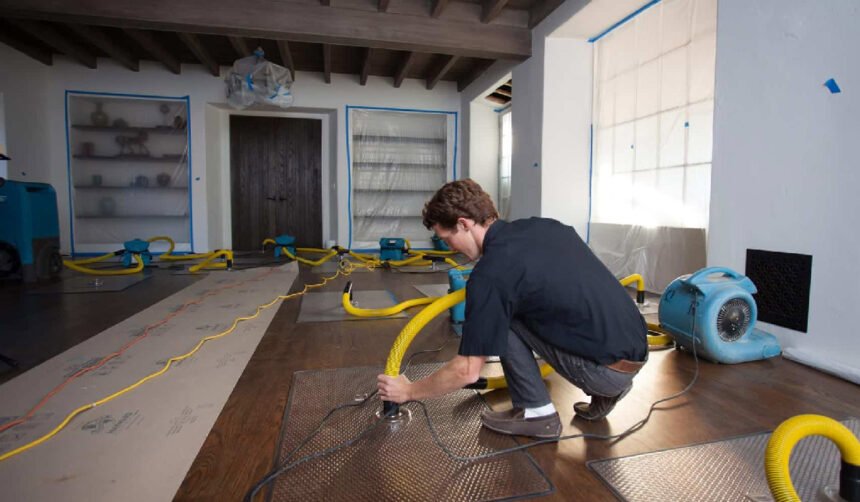Water damage can be one of the most devastating and costly issues a property owner faces. Whether it’s from a burst pipe, a leaking roof, or a natural disaster, water intrusion can destroy belongings, compromise structural integrity, and promote mold growth. That’s where Water Damage Restoration becomes not just necessary, but urgent.
This article explores what water damage is, the common causes, the step-by-step restoration process, and tips on prevention. Whether you’re a homeowner, business owner, or property manager, understanding how water damage restoration works can save you time, stress, and thousands of dollars.
What Is Water Damage?
Water damage refers to the destructive effects that excess water can have on structures, materials, and systems within a building. It may seem harmless at first — a slow drip or a puddle near the base of a wall — but left untreated, even small leaks can lead to significant structural and environmental issues.
Common signs of water damage include:
- Peeling paint or wallpaper
- Warped or buckling flooring
- A musty odor in specific rooms
- Visible mold or mildew
- Discoloration on walls or ceilings
Understanding the early warning signs can help you take action before the damage escalates.
Common Causes of Water Damage
Water damage doesn’t just result from massive floods or storms. Everyday issues within a property are just as likely to cause problems. Here are the most frequent causes:
1. Plumbing Failures
Burst pipes, leaking faucets, or corroded plumbing systems can introduce a steady flow of water into unwanted areas. These issues often go unnoticed until significant damage is already done.
2. Roof Leaks
Worn or missing shingles, clogged gutters, and poor drainage can allow water to seep into the roof and attic, eventually dripping down into the walls and living spaces.
3. Appliance Malfunctions
Washing machines, dishwashers, water heaters, and HVAC systems can leak over time or malfunction, especially if not maintained regularly.
4. Basement Flooding
Basements are especially prone to flooding due to their below-ground position. Poor drainage, sump pump failure, or rising groundwater can all result in substantial damage.
5. Natural Disasters
Heavy rain, hurricanes, and flash floods can quickly cause severe water intrusion, overwhelming property defenses in a short time.
Categories and Classes of Water Damage
Not all water damage is the same. Restoration professionals classify damage by both category and class to determine the contamination level and the extent of the damage.
Categories of Water Damage
- Category 1 – Clean Water: From a sanitary source like a faucet or supply line.
- Category 2 – Gray Water: May contain contaminants; examples include dishwasher or washing machine overflow.
- Category 3 – Black Water: Highly contaminated, such as sewage backups or floodwater.
Classes of Water Damage
- Class 1: Minor damage, low absorption, affects part of a room.
- Class 2: Affects an entire room, including walls and flooring.
- Class 3: Water has saturated ceilings, walls, floors, and possibly insulation.
- Class 4: Deeply held moisture in materials like hardwood, brick, or plaster — requires specialized drying methods.
The Water Damage Restoration Process
Effective Water Damage Restoration requires a thorough and systematic approach. Here’s a step-by-step breakdown of how professionals handle the process:
1. Emergency Contact and Inspection
The first step is contacting a restoration service. Most providers offer 24/7 emergency service because time is crucial. Upon arrival, technicians inspect the property to assess the severity and type of water damage.
2. Water Extraction
Standing water is removed using pumps and vacuums. This step is vital to prevent further damage and reduce the risk of mold and bacteria spreading.
3. Drying and Dehumidification
After water is removed, surfaces may still retain moisture. Industrial-grade dehumidifiers and air movers are used to dry the affected areas thoroughly. Depending on the extent of damage, this step may take several days.
4. Cleaning and Sanitizing
All affected items and surfaces must be cleaned and disinfected to prevent microbial growth. This includes:
- Antimicrobial treatments
- Air scrubbers
- Odor removal with fogging machines
5. Restoration and Repairs
The final stage includes repairing or replacing damaged drywall, flooring, insulation, and sometimes structural elements. The goal is to return the property to its pre-loss condition.
Why Professional Water Damage Restoration Matters
While minor water issues can sometimes be handled with DIY solutions, anything beyond a small spill requires professional expertise. Here’s why:
- Proper Equipment: Professionals use moisture meters, thermal imaging, industrial-grade vacuums, and dryers that aren’t available in retail stores.
- Expertise: Restoration experts understand how to identify hidden moisture, avoid mold, and restore complex structural components.
- Speed: Time is critical. Trained teams can mitigate damage faster than a homeowner attempting to research and fix the issue themselves.
- Insurance Handling: Many companies work directly with insurers, helping you navigate claims efficiently.
Skipping professional water damage restoration can result in incomplete drying, unseen mold growth, and weakened structures — all of which cost more down the line.
Mold and Secondary Damage
Water damage isn’t just about wet floors and soggy drywall. If left untreated, it can lead to secondary issues — the most dangerous of which is mold growth.
How Quickly Does Mold Grow?
Mold can begin to develop within 24–48 hours of water exposure, especially in warm, dark, and humid environments.
Health Risks of Mold:
- Respiratory problems
- Allergic reactions
- Skin irritation
- In extreme cases, neurological effects
Mold remediation often becomes part of the water damage restoration process if discovered early. If ignored, it can become a separate, expensive problem requiring specialized removal and containment services.
How to Prevent Water Damage
Prevention is always better — and cheaper — than restoration. Here are some practical steps property owners can take:
1. Regular Inspections
- Check roofs, gutters, and plumbing systems twice a year.
- Inspect appliances for leaks or wear.
2. Install Water Sensors
- Smart water detectors can alert you to moisture in vulnerable areas like basements or under sinks.
3. Maintain Proper Drainage
- Ensure gutters and downspouts are clear and direct water away from the foundation.
4. Seal Windows and Doors
- Caulking and weather stripping help keep water out during heavy rain.
5. Know How to Shut Off Water
- In case of a burst pipe, knowing how to shut off the main valve can prevent extensive damage.
FAQs About Water Damage Restoration
Is water damage covered by insurance?
Most standard homeowner’s insurance covers sudden and accidental water damage (like a burst pipe) but not gradual leaks or flooding unless you have additional coverage.
Can I stay in my home during restoration?
Depending on the damage, it may be safe to stay, but in severe cases with structural concerns or mold, temporary relocation is recommended.
Conclusion
Water damage can be a silent and destructive force, compromising your home or business without much warning. Understanding the causes, signs, and restoration process equips you to act quickly and responsibly.
If you ever find yourself dealing with water intrusion, don’t wait. Hiring a professional water damage restoration service can be the difference between a quick fix and a long-term nightmare.For More Information, Visit Dotmagazine








